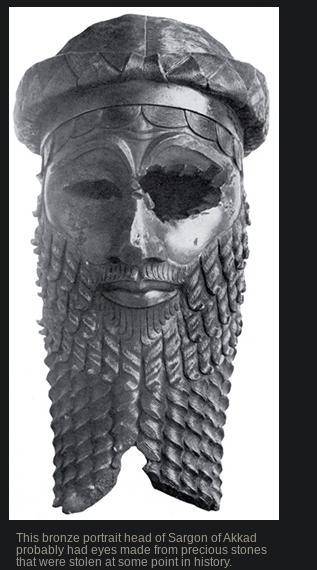
Arts, 05.11.2020 04:00 kayolaaaa53
Click to review the online content. Then answer the question(s) below, using complete sentences. Scroll down to view additional questions.
Art of the First Cities in the Third Millennium
The Neolithic Revolution was just that: a revolution. Like all revolutions, it had unforeseen effects. One of these was urbanization, or the development of cities. Over time, developments in agriculture grew to the point that an entire community could be fed without every member working to grow food. As a result, other professions arose. One of these was the artist.
The first artists worked in clay, stone, and bronze. Their works commemorated rulers and religious figures and were often used for either utility or for ritual purposes. Over time, a trade developed in the arts that was further advanced by the development of another profession, the merchant.
Urban Life
By the third millennium BCE, the roots of modern urban civilization had been planted. The Sumerian city-states were well established in southern Mesopotamia and populated by people who called themselves sag giga (“black-haired ones”). Between the Mediterranean and the Indus Valley, many other empires and city-states had arisen. Artistic expression, along with the invention of writing, blossomed in great Mesopotamian city-states such as Ur.
As the cities grew, so did a stratified society, as well as a demand for luxury items by the elite. Many of these items were fashioned from imported materials, such as lapis lazuli from present-day Afghanistan. Routes were built to connect the Mesopotamian cities to other parts of the known world. These facilitated trade in such materials. Around 2350 BCE, the ruler Sargon of Akkad founded the Akkadian dynasty and a central political center in southern Mesopotamia. Uniting Mesopotamia, western Syria, Anatolia, and Iran at its highest point, the Akkadian Empire was in fact the first great empire in the world.
The Art of Mesopotamia
By the third century BCE, a distinct artistic style had already been established to define the Middle East and its people. Like most ancient art, it was religious in nature. Mesopotamian artists attempted to depict the relationship between the earthly and the heavenly. Most early Sumerian art was in the form of sculpture and found in the temple sphere. Votive statues have been found in ancient Sumerian temples that are believed to represent worshippers. These statues show people who are highly individual, with distinct hairstyles and clothing and of different shapes and sizes. However, all of them have widely open eyes, as if they are constantly alert.
Akkadian sculpture took a different approach. A few portraits of Akkad’s rulers still exist, most notably the bronze head of Sargon himself. The detail found in this sculpture, created using the lost-wax method of metal casting, suggest great advances in technology from the earliest works of Sumer—probably reflecting the influence of nearby cultures such as Egypt. Sculptures such as this were probably richly adorned with precious stones and metals, but have lost much of their original quality due to centuries of pillaging and neglect.
In Mesopotamia, the third century BCE was an important chapter in humanity’s history. It had a great impact on politics, economics, and urban culture that has endured to this day. The artwork of the era reflects this influence.
Describe the artistic style of Mesopotamian artists by the third century BCE.



Answers: 3


Another question on Arts

Arts, 23.06.2019 03:00
Most of the sculptures from the later classical greek art. are what because they were made from mold
Answers: 2

Arts, 23.06.2019 12:00
The main subject of greek art during the classical period was?
Answers: 2

Arts, 23.06.2019 17:10
The venus of willendorf and other similar statuettes have the following characteristics except for
Answers: 1

Arts, 24.06.2019 17:00
Today's generation didn't want to watch ancient actors reciting the same tired lines. they wanted to see themselves reflected onscreen - rude, raw, entitled. these kids needed to believe that they themselves were only one daring, controversial act away from being up on that screen themselves. " - melissa jo peltier, reality boulevard within the past few years, reality tv has become a staple in the homes of people not just in america but around the world. many celebrities have given in to the undeniable effect of reality tv, choosing to have their own lives played out in front of the lens. the term "reality tv star" has been coined and is now being uttered on the lips of millions. however one feels about reality tv, this wave of entertainment seems to be here to stay. while form of low art achieves wild popularity and brings in significant profits to networks, attendance to broadway theater performances is also at an all-time high. perhaps low art and high art can thrive simultaneously. what do you think will be the lasting impact that reality tv has on the humanities and how we see ourselves as humans? based on what you learned about the theater (which was not always considered high art) in this week's readings, what may be some future similarities and differences between reality tv and the theater?
Answers: 1
You know the right answer?
Click to review the online content. Then answer the question(s) below, using complete sentences. Scr...
Questions

Social Studies, 06.08.2019 20:10


Mathematics, 06.08.2019 20:20

Mathematics, 06.08.2019 20:20


Mathematics, 06.08.2019 20:20


Mathematics, 06.08.2019 20:20

Social Studies, 06.08.2019 20:20


Biology, 06.08.2019 20:20

History, 06.08.2019 20:20




Physics, 06.08.2019 20:20


Physics, 06.08.2019 20:20




